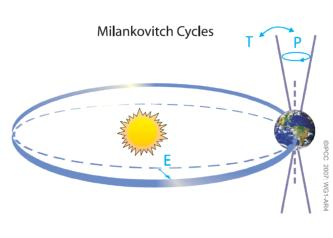Ice Ages | Little Ice Age | Volcanoes
Ice Ages
Twenty thousand years ago, ice extended over large parts of the Northern Hemisphere and Europe as the last ice age reached its maximum. This event was part of the natural cycle of long glacial and shorter, warmer, interglacial periods which has characterised the climate of the last million years or so. The main cause of the ice age cycles is the predictable changes in the character of the Earth's orbit around the Sun and its rotation which affect the way in which the energy from the Sun is distributed by season and by latitude. This effect -the Milankovitch effect- is magnified by other factors such as the release and uptake of carbon dioxide. According to this effect, the Earth would not naturally enter another ice age for at least thirty thousand years. However, modelling studies suggest that anthropogenic climate change will significantly delay the onset of the next ice age, and weaken its intensity. It is even possible that anthropogenic warming may weaken the feedback mechanisms which amplify the orbital changes sufficiently to prevent the future initiation of glaciation.

Milankovitch theory of Ice Ages
Visit Milankovitch for an entertaining and more detailed look at these cycles.
